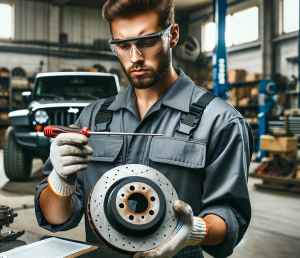Brake rotors play a pivotal role in your Jeep’s braking system, acting as the surface against which the brake pads press to slow or stop your vehicle. These components are essential for converting kinetic energy into thermal energy through friction, a process that is critical for safe driving. Rotors must be robust to withstand the high temperatures generated by braking without warping or failing. Over time, wear and tear on these components can affect their performance, making regular inspections and maintenance crucial. Understanding how rotors work, and the signs of wear can help ensure that your Jeep remains safe and responsive on the road.
Differences Between Front and Back Rotors
The design differences between front and back rotors in your Jeep are deliberate, reflecting the unique roles they play in the vehicle’s braking system. The front of the vehicle bears the brunt of the braking force due to the forward momentum of the vehicle during deceleration. This means the front rotors are usually larger and made thicker to handle the additional stress and heat. Conversely, the rear rotors are tasked with providing stability and support to the braking system, necessitating a different size and sometimes even a different material composition. These differences are crucial for achieving balanced and effective braking, ensuring that your Jeep stops smoothly and safely under various driving conditions.
Factors Influencing Rotor Size and Design
The size and design of brake rotors are influenced by several important factors:
-
Vehicle Weight: Heavier vehicles require larger rotors that can generate the necessary braking force to safely bring the vehicle to a stop.
-
Driving Conditions: Vehicles driven in demanding conditions, such as off-roading or racing, benefit from rotors designed to handle extreme heat and stress.
-
Brake System Design: The specifications of the braking system, including the type and size of the brake calipers, directly impact rotor design.
-
Heat Dissipation Needs: Effective heat management is crucial for maintaining brake performance. Larger rotors with specific designs, such as drilled or slotted surfaces, improve air circulation and heat dissipation.
Selecting rotors that match your Jeep’s specifications and your driving needs is essential for maintaining optimal braking performance and safety.
Recognizing When to Replace Rotors
Identifying the right time to replace the brake rotors on your Jeep is crucial for maintaining optimal braking performance and safety. Worn rotors can lead to decreased braking efficiency, longer stopping distances, and even potential brake system failure. Key signs that indicate the need for rotor replacement include: noticeable decrease in braking responsiveness, a pulsating feeling through the brake pedal, which often indicates rotor warping, and audible signs such as squealing or grinding noises during braking, suggesting that the rotors are worn down. Additionally, visual inspection may reveal grooves, cracks, or significant wear on the rotor surface, signaling that replacement is necessary. Timely attention to these warning signs can prevent more costly repairs and ensure your safety on the road.
Selecting the Correct Rotors for Your Jeep
Choosing the correct rotors for your Jeep involves more than just matching the right size. Consideration should be given to the specific needs of your vehicle and driving habits:
- Ensure compatibility by verifying the rotor size and type against your Jeep model and year.
- Assess your driving conditions. If you frequently drive off-road or in mountainous areas, consider rotors designed for high performance and heat resistance.
- Look into specialized rotors if you have specific needs. For instance, Best Rotors for Jeep might offer enhanced features such as improved heat dissipation or reduced brake fade, which are ideal for heavy-duty use or performance driving.
Making an informed choice will not only enhance your Jeep’s braking performance but also contribute to the longevity of your brake system.
Conclusion
In conclusion, the front and back rotors in your Jeep are not identical. They are designed with distinct specifications to fulfill the different requirements of the vehicle’s braking system. Acknowledging these differences is crucial for the appropriate maintenance and operation of your Jeep. Properly selected and maintained rotors ensure the vehicle’s braking system functions effectively, providing safety and reliability under various driving conditions. Regular inspection and timely replacement of your Jeep’s brake rotors are essential practices that contribute significantly to the vehicle’s overall safety and performance on the road. Remember, when it comes to vehicle maintenance, especially components as critical as the braking system, always opt for quality parts and professional advice.

 Vehicle Weight: Heavier vehicles require larger rotors that can generate the necessary braking force to safely bring the vehicle to a stop.
Vehicle Weight: Heavier vehicles require larger rotors that can generate the necessary braking force to safely bring the vehicle to a stop.
Add Comment